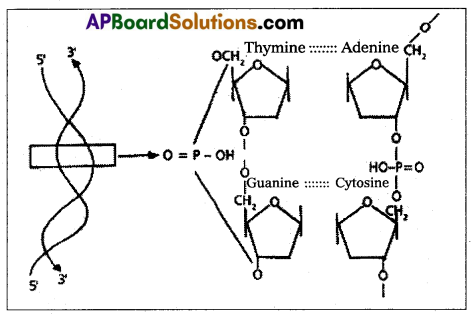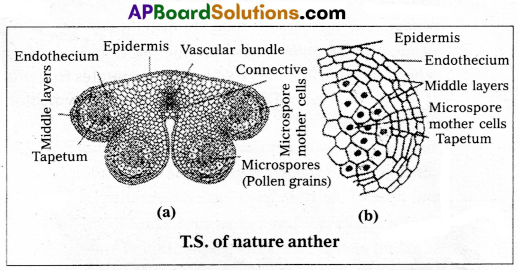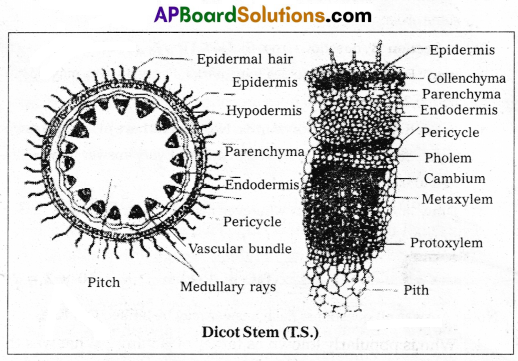Successful navigation through TS Inter 1st Year Botany Model Papers and TS Inter 1st Year Botany Question Paper May 2018 builds students’ confidence in their exam-taking abilities.
TS Inter 1st Year Botany Question Paper May 2018
Time: 3 Hours
Maximum Marks: 60
General Instructions:
Note : Read the following instructions carefully.
- Answer all questions of Section – ‘A’. Answer any six questions out of eight in Section – ‘B’ and answer any two questions out of three in Section – ‘C’.
- In Section – ‘A’, questions from Sr. Nos. 1 to 10 are of “Very Short answer Type”. Each question carries two marks. Every answer may be limited to 5 lines. Answer all the questions at one place in the same order.
- In Section – ‘B’, questions from Sr. Nos. 11 to 18 are of “Short Answer Type”. Each question carries four marks. Every answer may be limited to 20 lines.
- In Section – ‘C’, questions from Sr. Nos. 19 to 21 are of “Long Answer Type”. Each question carries eight marks. Every answer may be limited to 60 lines.
- Draw labelled diagrams wherever necessary for questions in Section – B’ and C’.
Section – A (10 × 2 = 20)
Note : Answer all questions. Each answer may be limited to 5 lines.
Question 1.
What is Systematics ?
Answer:
Study of different organisms, their variations and relationships is called systematics.
Question 2.
What are the groups of plants the live as symbionts in lichens ? Name the study of lichens.
Answer:
Algae and Fungi live as symbionts in Lichens. The study of Lichens in called lichenology.
Question 3.
Given the main criteria used for classification by Whittaker.
Answer:
The main criteria for classification proposed by Whittaker include cell structure, thallus organisation, mode of nutrition, reproduction and phylogenetic relationships.
![]()
Question 4.
Why certain fruits are called false fruits ? Name two examples of plants having false fruits.
Answer:
Fruits which are formed from other parts of the flower along with ovary are called “false fruits”.
Ex : Apple – Thalamus develops into false fruit.
Cashew nut – Pedicel develops into false fruits.
Question 5.
Differentiate fibrous roots from adventitious roots.
Answer:
| Fibrous roots | Adventitious roots |
| Large number of roots arise from the base of the stem are called fibrous roots. | Roots arise from any other part of the plant other than the radicle are called adventitious roots. |
Question 6.
What is ‘Omega Taxonomy’ ?
Answer:
Taxonomy based on Information from other Branches i.e., Embryology, Cytology, Palynology, Phytochemistry, Serology etc., along with morphological characters is called omega taxonomy.
Question 7.
What is the significance of vacuole in a plant cell ?
Answer:
In plants, Vacuole contains sap mainly composed of water, metaboloic bye products, excretions and other waste materials. They also play an important role in osmo regulation.
Question 8.
What is middle lamella made Of ? What is its functional significance ? .
Answer:
Middle lamella is made up of calcium pectate and magnesium pectate. It holds or glues the different neighbouring cells.
Question 9.
Given that the average duplication time ofE. Coli is 20 minutes. How much time will two E. coli cells take to become 32 cells?
Answer:
80 Minutes.
Question 10.
Define Heliophytes and Sciophytes.
Answer:
Plants grow in direct sunlight are called Heliophytes. Plants grow in shady places are called Sciophytes.
![]()
Section – B (6 × 4 = 24)
Note : Answer any six questions. Each answer may be limited to 20 lines.
Question 11.
Write the role of Fungi in our daily life.
Answer:
Uses :
- Yeast is used to make bread and beer.
- Some fungi like Pencillium are the source of antibiotics.
- Some fungi like Agaricus are edible mushrooms.
Disuses :
- Some fungi cause root of orange fruits.
- Fungi spoils bread.
- Albugo causes white rust diesease on Brassica leaves.
- Puccinia causes rust in wheat.
Question 12.
What is meant by homosporous and heterosporous pterido-phytes ? Give two examples.
Answer:
The condition where only one type of spores are produced is called Homosporous pteridophytes.
Ex : Psilotum, Lycopodium.
The condition where different types of spores are produced is called Heterosporous pteridophytes.
Ex : Selagenella, Salvinia.
Question 13.
Discuss the various types of pollen tube entiy into ovary with the help of diagrams.
Answer:
Pollen tube enters into the ovule from ovary by three ways.
They are
a) porogamy : Pollen tube enters into the ovule through Microphyle.
Ex : Ottelia, Hibiscus.
b) Chalazogamy: “Pollen tube enters into the owle through Chalaza”.
Ex : Casuarina.
c) Mesogamy : “Pollen tube enters into the ovule through the integuments”.
Ex : Cucurbita.

Question 14.
Describe the essential floral parts of plants belonging to Liliaceae.
Answer:
The essential floral parts of Liliaceae are Androecium and Gynoecium.
Androecium : Six stamens in two whorls, free or epiphyllous, anthers are dithecus, basifixed, introrse and dehisce longitudinally.
Gynoecium : Tricarpellary, syncarpous, trilocular, superior ovary with many ovules on axile placentation. Style is terminal and stigma is trifid or capitate.
![]()
Question 15.
What are the characteristics of a prokaiyotic cell ?
Answer:
- Prokaryotic cell organisation is fundamentally similar.
- Prokaryote shows a wide variety of shapes and functions.
- All prokaryotic cells have cell wall surrounding the cell membrane.
- The fluid matrix filling the cell is the cytoplasm.
- There is no well defined nucleus.
- The genetic material is basically naked, that means not enveloped by a nuclear membrane.
- In addition to the genomic DNA (circular DNA) many bacteria have small circular DNA outside the genomic DNA. These smaller DNAs are called plasmids.
- No organelles like in eukaryotes are found except in ri-bosomes.
- A specialized differentiated form of cell membrane called mesosome is the characteristic of prokaryotic cell.
- It is essentially an infolding of the cell membrane.
Question 16.
Nucleic acid exhibits secondary structure, justify with example.
Answer:
Nucleic acids exhibits a wide variety of seconary structure. For example, one of the secondary structures exhibited by DNA is Watson Crick model. According to this, DNA exists as a double helix. The two stands of polynucleotides are antiparallel i.e., run in the opposite direction. The backbone is formed by the sugar – phosphate, sugar chain. The nitrogen bases are projected more or less perpendiular to this back-bone but face inside. A combines with T by two hydrogen bonds where G combines with C by three hydrogen bonds. One full turn of the helical strand would involve ten base pairs. The length of one coil is 34 Å and the distance between base pairs is 3.4 Å. It is also called B-DNA.

Question 17.
A transverse section of the trunk of a tree shows concentric rings which are known as annual rings. How are these rings formed ? What is the significance of these rings ?
Answer:
In temperate regions and cold regions, the activity of the canbium is influenced by the seasonal variations. During the spring season, more leaves and flowers are formed. Hence the plant requires large amount of water and mineral salts. So the wood formed in this period shows more number of xylem vessels with wides lumens. This wood is called spring wood or early wood. In autumn season, the plants are less active and do not require more water and mineral salts. Hence the wood produced in this period shows less number of xylem vessals with narrow lumens. This is known as autumn wood or late wood.
In this way, two types of wood are produced and appear in the form of alternative circles. These are called annual rings or growth rings.
Importance : By counting the number of annual rings, we can estimate the approximate age of the plant. This branch of science is known as Dendrochrenology.
Question 18.
Enumerate the morphological adaptations of hydrophytes.
Answer:
Morphological adaptations:
A. Roots : Plenty of water is available to hydrophytes. So . roots are of secondary importance, less significant and hence poorly developed.
a) Roots are absent (Wolffia and Ceratophyllum) or poorly developed (Hydrilla) or submerged leaves act as roots as in Salvinia.
b) Root caps are absent or replaced by root pockets (Pistia). Amphibious plants that grow in mud possess distinct root caps.
c) If roots are present they are fibrous, adventitious, reduced in length, unbranched or poorly branched. Balancing roots are present in Pistia and Fichhomia.
B. Stems :
a) Stem is long, slender and flexible in submerged forms like Hydrilla arid Potamogeton. Stem in Eichhomia (free – floating form) is thick, short and spongy.
b) Stem modified into rhizome is Nymphaea and Nelumbo.
C. Leaves :
In submerged forms, the leaves are like thick, long, ribbon shaped (Vallisneria) or long and linear (Potamogeton) or finely dissected (Ceratophyllum). In Nymphaea, Nelumbo and Victoria, the floating leaves are large, flat and coated with wax on their upper surfaces.
![]()
Section – C (2 × 8 = 16)
Note : Answer any two questions. Each answer may be limited to 60 lines.
Question 19.
Explain how stem is modified variously to perform different functions. Give any six modifications with diagrams and examples.
Answer:
Stems are modified in several ways to perform different functions.
They are:
1) Tendrils : Slender, spirally coiled structures which may develop either from auxiliary bud (cucumber) or from terminal bud (grapes) are called tendrils. They help in climbing.
2) Thorns : Buds are modified into woody, straight pointed thorns which protect plants from grazing animals.
Ex: Citrus, Bougain villaea.
3) Phylloclade : In some plants of acid zones, leaves are modified into scales or spines to reduce the rate of tran-spiration. In such plants, stems are modified into flattened, green structure which carryout photosynthesis. Such stems are called phylloclades.
Ex : In euphorbia stem is cylindrical, in casuarina needle like, and in opuntia – flattened, fleshy green.
4) Bulbils: In some plants, the vegetative buds or floral buds store food materials. At maturity, may detach from the parent plants, develop adventitious roots, grow as new plants thus help in vegetative reproduction. Ex : Diascoria.
5) Underground stems : In some plants, stem grows into soil, store food materials, show perennation, to resist unfavourable conditions and also help in vegetative reproduction. Such stems are called underground stems. Ex : Rhizome – Ginger, com – colacacia.
6) Sub aerial stems : In some plants, some part of the stem is underground and some part is aerial. Such stems are called sub aerial stems. In such plants, slender, lateral branches arises from the base of the main axis, grow vertically, arches downwards, produce adventitious roots when touches the ground. When they separates from the parent plant, they develop into new plants they help in vegetative reproduction.
Ex : Stolons – Nerium, Jasmine Suckers – Chrysanthemum, Mertha.

Question 20.
Draw the diagram of a microsporangium and label its wall alyers. Write briefly about the wall layers.
Answer:

Anther wall consists of
a) One cell thick outer protective layer, epidermis. The thin walled epidermal cells between two pollen sacs constitute stomium, which is useful for the dehiscence of pollen sacs.
b) Endothecium, a layer of radially expanded cells present below the epidermis. These cells have hygroscopic fibrous thickenings of cellulose and help in the dehiscence of pollen sac.
c) Middle layers present below the endothecium consists of 1 – 5 layers of thin walled cells.
d) Tapetum is the innermost nutritive layer of anther wall, which encircles the sporogenous tissue. The cells in this layer are large, thin walled, bi – or multinucleate and nourish the developing sporogenous tissue.
![]()
Question 21.
Describe the T.S. of a dicot stem.
Answer:
The structure of young dicot stem can be clearly understood by observing the transverse section of stem of Helianthus
annus (sunflower). It shows three major zones, namely epidermis, cortex and stele.
1. Epidermis : It is the outer most layer of rectangular or tabular cells arranged compactly without any intercellular spaces. On outer surface of epidermis, a waxy layer called Cuticle is found. The cuticle is chemically composed of a substance cutin. The cell walls of epidermis also show the presence of cutin. Stomata are present in the epidermis. Multicellular trichomes develop on the epidermis. The cuticle and the trichomes check the evaporation of water and protect the stem from high temperature.
The epidermal layer gives protection to the inner tis-sues and also prevents the evaporation of water from the plant body. Through stomata, the epidermis allows the exchange of gases and promotes transpiration. Trichomes prevent entry of pathogens.
2. Cortex : The part extending between the epidermis and the stele is known as cortex. The cortex is smaller than the stele. It shows three sub-zones, namely
i) Hypodermis
ii) General Cortex and
iii) Endodermis.
i) Hypodermis : This is the outermost part of cortex and t composed of 3 – 6 rows of collenchymatous cells. It is found beneath the epidermis and helps in providing tensile strength (elasticity) to the stem. The cells are arranged compactly without intercellular spaces and show excessively thickened comers. The cells are filled with active vacuolated cytoplasm possessing chloroplasts. Thus, the hypodermis also helps in the assimilation of food materials. It also gives mechanical strength.
ii) General Cortex: It is found beneath the hypodermal layer and is made up of 5 – 10 rows of thin walled,living parenchyma cells with or without intercellular spaces. The outer layers of cells contain chloroplasts and in the inner layers, leucoplasts are found. The general cortex is primarily concerned with the assimilation and storage of food materials.
iii) Endodermis : The inner most layer of cortex is called endodermis. The cells are barrel shaped, compactly arranged without intercellular spaces. The endodermis cells contain vacuolated protoplasts and show starch grains. So it is also known as ‘Starch Sheath’.
3) Stele : The central conducting cylinder is called the ‘stele’. It occupies a major part of the stem. It is composed of 4 parts.
i) Pericycle
ii) Vascular bundles
iii) Pith or Medulla and
iv) Medullary rays.
i) Pericycle : It is present in the form of a discontinuous ring and is made up of 3 – 5 rows of the thick walled, dead, lignified cells which gives mechanical strength to the stele. It appears as semilunar patches of sclerenchyma above the vascular bundles with intervening masses of parenchyma.
ii) Vascular bundles : About 15 – 20 vascular bundles are arranged in the form of a ring. This arrangement is called Eustele. Each vascular bundle is wedge or top shaped. In the vascular bundels, xylem and phloem are arranged on the same radius. A meristematic layer of cells called cambium is present in between the xylem and phloem. So they are called conjoint, collateral and open vascular bundles. Xylem is at the lower side and phloem at the upper side of the vascular bundle.
Xylem consists of vessels and xylem parenchyma. There may be few tracheids and xylem fibres. The metaxylem is towards the pericycle and protoxylem towards the pith. This is called endarch xylem. Phloem consists of sieve tubes companion cells and phloem parenchyma. Xylem and phloem are vascular tissues which conduct water, mineral salts and organic solutes respectively.
iii) Medulla (or) pith : It is the central part of the stele and filled with thin walled parenchymatous cells, showing intercellular spaces. It is well – developed, extensive and occupies a large part of the stele. The chief function of the medulla is to store food materials.
iv) Medullary rays : They are found in between the vascular bundles. They show many horizontal rows of thin walled radially elongated living cells which help in lateral conduction of food materials.
